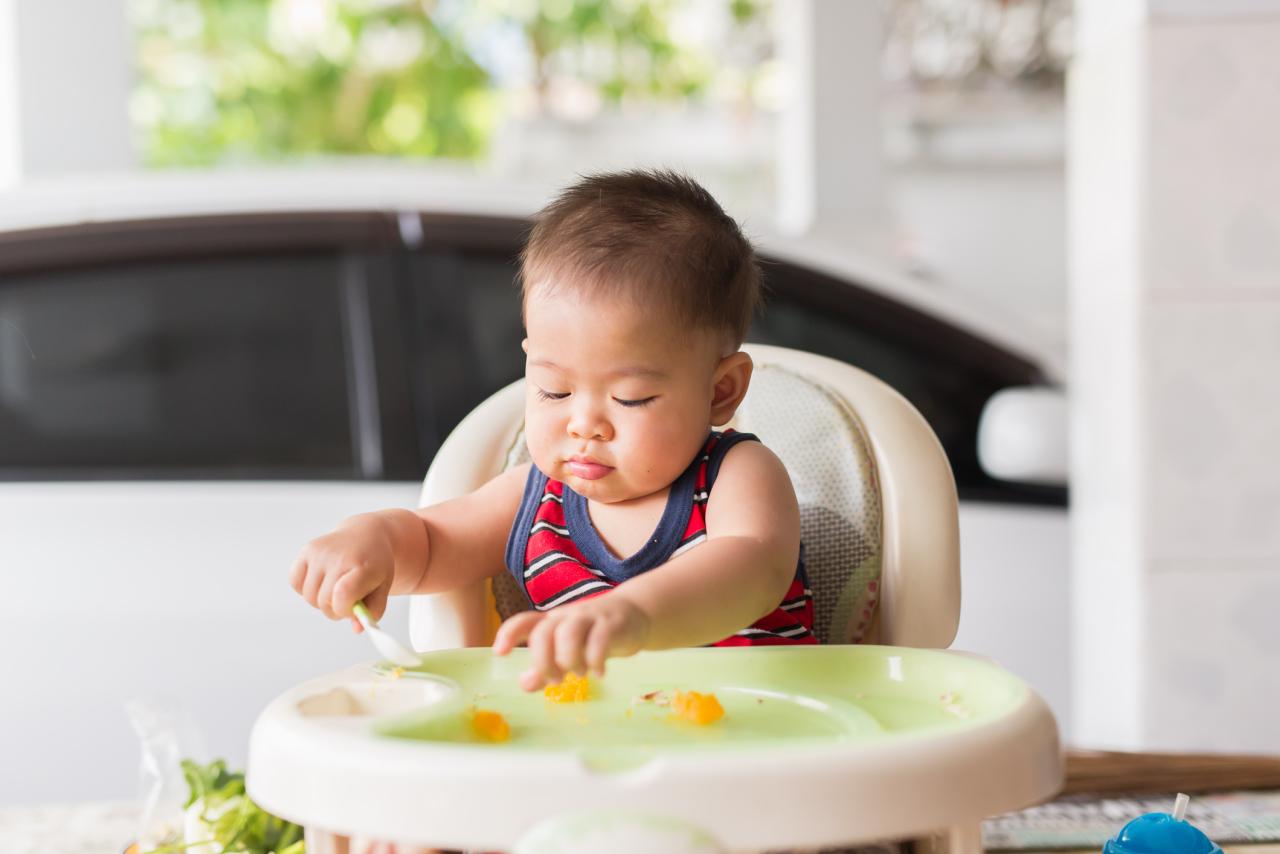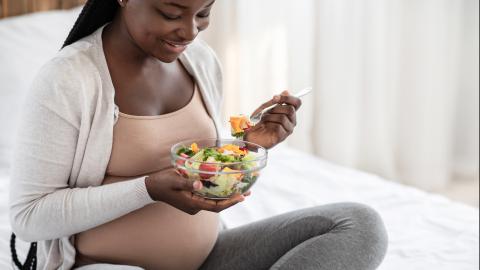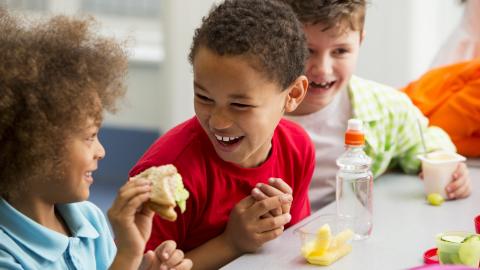Resource
Eating & nutrition for infants to 18 months

For the first six months, your baby should only have breast milk. They should be deciding when and how much to drink. They should not have anything else to eat or drink, including water. However, giving your baby a Vitamin D supplement is essential if they are breastfed or drinking breast milk in combination with formula. The supplement should be 400 IU of Vitamin D every day during this time. As you think about moving from breast milk to solid food, you may find the following information useful.
Introducing solid foods
Breast milk is the only food your baby will need until they are about six months old. Continue offering breast milk until the baby is two years old, but add new foods at six months. It's also a great time to start having meals as a family.
Babies are ready for solids when they:
- Are curious about the food you're eating
- Can sit and hold their head up by themselves
- Open their mouths to take food from a spoon
- Turn their head away to show they don't want food
- Close their lips over the spoon
- Keep food in their mouth and swallow instead of pushing it out.
Start a new food when your baby is happy and hungry! If your baby does not swallow the food, wait a few days and try again. Sometimes it takes up to 20 tries before your baby will like it.
Tips for introducing solid foods
- You decide what food is offered and at what time.
- Your baby decides which of the provided foods to eat and how much.
- Forcing your baby to eat is never a good idea. You'll only create future problems.
- Make meal times fun and encourage healthy food choices.
- Be a good role model. Your choices influence your baby's eating habits and attitude.
What to feed your baby
Iron-rich food
Iron helps a baby grow and be healthy. Your baby's first foods should be rich in iron because the iron they were born with is running low. A baby without enough iron may have a poor appetite, develop slowly, get sick more often, and be tired. Learn more about why iron is essential for healthy development.
- Iron and your health - HealthLink BC
Start with one spoonful of a single iron-rich food and try to offer these foods two to three times each day. Some healthy iron-rich foods to try are:
- Well-cooked finely minced or shredded meat, poultry or fish
- Mashed cooked egg, lentils or cooked tofu
- Single-grain iron-fortified infant cereal
- List of iron in foods - HealthLink BC
Food variety
Try to offer a variety of food from Canada's Food Guide. You do not need to puree food. Simply mushing it with a fork is good enough. If you start with pureed baby food, move to well-mashed food within a few weeks of starting solids. It is also important to introduce a variety of textures from other food groups beginning at six months. It would be best if you also offered a variety of finger foods as a part of the first solid foods.
By nine months of age, offer your baby the same foods the family eats. You may offer small amounts of whole milk once your baby is 9-12 months old and eats various iron-rich foods.
Fish
Fish is an excellent source of protein, iron and many other nutrients. However, some fish have higher levels of mercury, which might harm the brain. Infants 6-12 months should only have ½ serving (40 grams or 1 ¼ ounces) per month. Children over one can have one serving (75 grams) per month. Fish that are high in mercury are fresh or frozen tuna, shark, marlin, swordfish, escolar and orange roughy. Learn more about mercury in fish on HealthLink BC.
Finger foods
Around six months, babies learn to chew food with their jaws and gums. Babies don't need teeth to eat soft foods. When you first give your baby solids, begin by spooning them small amounts of mushy food. However, it's just as important for babies to learn to feed themselves. Babies may hold finger foods a lot but only eat a little. This is okay. Finger foods help babies:
- Explore their food through taste and touch
- Learn to use their jaws and gums
- Have fun creating a big mess
Offering finger foods
When giving your baby finger foods, try to offer as many foods as possible from various food groups. You can often share your meal with your baby. Follow some guidelines on making baby food, and ensure that you follow safe food handling practices.
Prevent choking
Babies learn how to eat until they are about four years old. They are still at risk of choking. You can do a lot to prevent choking by taking a few easy steps.
- Always be in the same room while your baby is eating.
- Feed your baby while they are sitting in a high chair
- Avoid these foods: nuts, raisins, popcorn, hard/small candies, marshmallow, gobs of peanut butter or gooey cheese.
- Cut these foods into small pieces: olives, grapes, raw vegetables, and hot dogs (cut lengthwise first, then into small pieces)
Choking versus gagging
Gagging can sometimes look like choking, but gagging is a normal part of learning how to eat. Choking means that there is no air moving. Your baby will start to look blue and unable to make any sounds. If this happens, call 9-1-1 right away.
Drinking with cups
Saying goodbye to the baby bottle can be challenging, but you can make it easier. When your baby is one year old, they should learn to use a cup and only use a baby bottle for water. Your baby should stop using the bottle entirely after 18 months.
Recipes
When it's time to start solid foods, you'll find a large selection of baby food in your grocery store. However, making your own baby food at home is easy (and it will save you money!).
- Offer the same foods to the whole family at meals. Remove your baby's portion from the recipe before adding salt, soy sauce or other high-sodium ingredients. You can use fresh and dried herbs in a recipe to add flavour.
- Offer new foods often and serve them with other familiar foods. Usually, making baby food is as simple as sharing your meal by following home-prepared baby food guidelines and following safe food handling practices.
Family meals
You can start having meals together as a family as soon as your baby eats solid foods. Your baby’s first foods can be plain foods that you eat. Eating together at home or a restaurant is a great way to connect and brings long-lasting benefits to your family. Most meals only take about 20 minutes. Even if you’re used to eating on the run, it’s easy to get into the habit of sitting down as a family.
Tips for family meals
- Make family meals a routine; expect everyone to sit together to eat.
- Make the same meal for everyone.
- Plan the weekly meal menu as a family. Make sure everyone gets at least one of their favourite meals.
- Let children help with grocery shopping, cooking and cleaning up as much as possible. Even babies can join you at the store or in the kitchen.
- Meals don’t need to take a lot of time to prepare. Make sandwiches, reheat leftovers, or grab a bag of salad or roasted chicken at the grocery store.
- Don’t bring your phones or tablets to the table; turn off the TV.
- Let children lead how fast (or slow) they want to eat. Let them decide which of the served foods to eat and how much.
- Involve everyone in the conversation and keep mealtimes fun.
- Check out the Better Together website for meal ideas and more tips.
Frequently Asked Questions
-
How much should I feed my baby?
Only your baby knows the answer to this question. You decide what foods to offer and when, but your baby should eat as much as they’d like. Some babies eat a lot. Others don’t seem to eat much at all. Your baby might eat a lot one day and very little the next day. This is all normal. If your baby is full, they will let you know by turning their head away or spitting food out. If they want more, they will keep opening their mouth or fuss when you take the food away. If you think there might be a problem with how much your child eats, call HealthLink BC at 8-1-1 and ask to speak to a dietitian.
-
My baby keeps gagging. Does that mean they're not ready for solid food?
Not at all! Gagging is a normal part of learning how to eat. All babies gag as they learn how to properly move food to the back of their mouths. It does not mean that you should stop feeding them or that they don’t like the food they are eating. If your baby gags, stay calm and reassure them gently.
-
Now that my baby is eating solid food, should I give them juice at meal time?
Meal time is a great time for your baby to learn how to use a cup. However, juice has a lot of sugar in it. It’s better to give water, but if you do give juice remember to give the kind without added sugar and limit it to no more than ½ cup per day.
-
I'm worried my baby will get fat, what should I do?
Babies come in different shapes and sizes. This is normal. Healthy babies know how much to eat because they are born that way. The best way to make sure your baby is a healthy weight is to:
- Offer healthy food
- Let your baby decide how much to eat
- Don’t hold back food from your baby when they’re hungry
- Give your baby lots of opportunities to be active during the day
Resources
-
-
8-1-1
free-of-charge provincial health information and advice phone line available in British Columbia.
-
HealthLink BC dietitian services
-
Find a Dietitian
Find a fee-for-service Dietitian near you. Dietitian coverage may be available using your extended health care benefits.
-
-
-
What to Feed Your Baby (English)
-
What to Feed Your Baby (Arabic)
-
What to Feed Your Baby (Trad. Chinese)
-
What to Feed Your Baby (Simp. Chinese)
-
What to Feed Your Baby (Farsi)
-
What to Feed Your Baby (Japanese)
-
What to Feed Your Baby (Korean)
-
What to Feed Your Baby (Punjabi)
-
What to Feed Your Baby (Spanish)
-
What to Feed Your Baby (Tagalog)
-
What to Feed Your Baby (Vietnamese)
-
-
-
Iron and your health
-
Canada's Food Guide
-
-
-
Finger Foods for Babies (English)
-
Finger Foods for Babies (Arabic)
-
Finger Foods for Babies (Trad. Chinese)
-
Finger Foods for Babies (Simp. Chinese)
-
Finger Foods for Babies (Farsi)
-
Finger Foods for Babies (Japanese)
-
Finger Foods for Babies (Korean)
-
Finger Foods for Babies (Punjabi)
-
Finger Foods for Babies (Spanish)
-
Finger Foods for Babies (Tagalog)
-
Finger Foods for Babies (Vietnamese)
-
-
-
Tasty Recipes for your Baby and Family
English
-
Tasty Recipes for your Baby and Family
Chinese Traditional
-
Tasty Recipes for your Baby and Family
Punjabi
-





